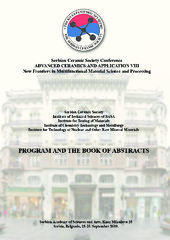Приказ основних података о документу
Application of magnetite/3D-printed wollastonite hybrid sorbent for As(V) removal from water
| dc.creator | Trajković, Isaak | |
| dc.creator | Obradović, Nina | |
| dc.creator | Marinković, Aleksandar | |
| dc.creator | Casas Luna, Mariano | |
| dc.creator | Pavlović, Vladimir | |
| dc.date.accessioned | 2019-12-31T02:52:36Z | |
| dc.date.accessioned | 2020-12-23T09:48:24Z | |
| dc.date.available | 2019-12-31T02:52:36Z | |
| dc.date.available | 2020-12-23T09:48:24Z | |
| dc.date.issued | 2019 | |
| dc.identifier.isbn | 978-86-915627-7-9 | |
| dc.identifier.uri | http://dais.sanu.ac.rs/123456789/6920 | |
| dc.identifier.uri | http://aspace.agrif.bg.ac.rs/handle/123456789/5744 | |
| dc.description.abstract | The maximal allowed concentration (MAC) for As(V) in water decreased from 50 to 10 μg/l, by considering the harmful effects of arsenic on the environment and human health. In order to achieve the established rigorous requirements, it is necessary to develop new materials and design new forms of adsorbents that can reduce the concentration of arsenic in drinking water. In this paper, the synthesized magnetite/3D-printed wollastonite hybrid sorbent was used to remove As(V) from aqueous solutions. 3D-printed wollastonite was obtained using the 3D-printing technique from methylhydrocyclosiloxane and calcium carbonate as precursors. Synthesis of adsorption material was carried out by depositing magnetite from an iron(II)-sulfate solution by potassium hydroxide on 3D-printed wollastonite. The adsorption properties of the hybrid adsorbent depend on the properties of magnetite and its porosity. This could be achieved by modifying the processes of depositing magnetite on the porous 3D-printed wollastonite. Characterization of the obtained material was performed using FTIR, SEM and TG-DTA. An investigation of the sorption properties of hybrid adsorbents was carried out for As(V) removal - one relative to the starting pH value of the solution, the adsorbent mass, the temperature and the adsorption time. Determination of adsorption parameters was performed by applying Langmuir, Freundlich and Dubinin- Radushkevich equations. Kinetics, using pseudo-first, pseudo-second and second order equations, as well as diffusion rate were determined using Veber-Moris and HSDM models. Determination of kinetics and adhesion parameters at three different temperatures enabled the calculation of thermodynamic and activation parameters of the adsorption process, which contributed to a better understanding of the adsorption mechanism. | en |
| dc.language.iso | en | sr |
| dc.publisher | Belgrade : Serbian Ceramic Society | sr |
| dc.relation | info:eu-repo/grantAgreement/MESTD/Basic Research (BR or ON)/172057/RS// | sr |
| dc.rights | openAccess | sr |
| dc.rights.uri | https://creativecommons.org/licenses/by-nc-nd/4.0/ | |
| dc.source | Program and the Book of abstracts / Serbian Ceramic Society Conference Advanced Ceramics and Application VIII : New Frontiers in Multifunctional Material Science and Processing, Serbia, Belgrade, 23-25. September 2019 | sr |
| dc.subject | magnetite | sr |
| dc.subject | 3D printing | sr |
| dc.subject | adsorption | sr |
| dc.subject | As(V) removal | sr |
| dc.subject | arsenic removal | sr |
| dc.subject | wollastonite | sr |
| dc.title | Application of magnetite/3D-printed wollastonite hybrid sorbent for As(V) removal from water | en |
| dc.type | conferenceObject | sr |
| dc.rights.license | BY-NC-ND | sr |
| dc.citation.epage | 52 | |
| dc.citation.spage | 52 | |
| dc.identifier.fulltext | http://aspace.agrif.bg.ac.rs/bitstream/id/22443/Trajkovic-ACAVIII.pdf | |
| dc.identifier.rcub | https://hdl.handle.net/21.15107/rcub_dais_6920 | |
| dc.type.version | publishedVersion | sr |


